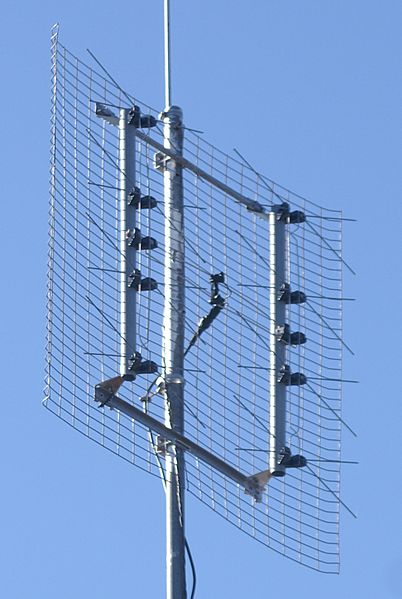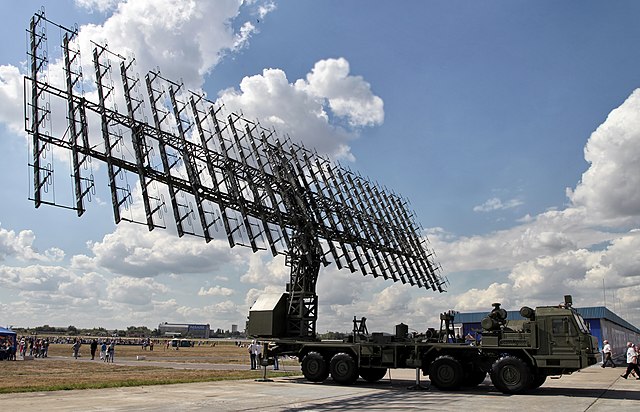In telecommunications and radar, a reflective array antenna is a class of directive antennas in which multiple driven elements are mounted in front of a flat surface designed to reflect the radio waves in a desired direction. They are a type of array antenna. They are often used in the VHF and UHF frequency bands. VHF examples are generally large and resemble a highway billboard, so they are sometimes called billboard antennas. Other names are bedspring array and bowtie array depending on the type of elements making up the antenna. The curtain array is a larger version used by shortwave radio broadcasting stations.
This reflective array television antenna consists of eight "bowtie" dipole driven elements mounted in front of a wire screen reflector. The X-shaped dipoles give it a wide bandwidth to cover both the VHF (174–216 MHz) and UHF (470–700 MHz) bands. It has a gain of 5 dB VHF and 12 dB UHF and an 18 dB front-to-back ratio. The example shown is horizontally polarised.
Reflective array 'billboard' antenna of the SCR-270 radar, an early US Army radar system. It consists of 32 horizontal half wave dipoles mounted in front of a 17 m (55 ft) high screen reflector. With an operating frequency of 106 MHz and a wavelength of 3 m (10 ft) this large antenna was required to generate a sufficiently narrow beamwidth to locate enemy aircraft.
A modern form of reflective array is the "bow tie" UHF television antenna. This example has two dipole driven elements in front of a grill reflector. The "bow-tie" dipoles, consisting of two V-shaped elements, have a larger bandwidth than ordinary dipoles, allowing the antenna to cover the wide UHF television band. This example is installed for reception of vertically polarized TV transmissions.
Enormous reflective array antenna of the Duga or "Steel Yard" over-the-horizon (OTH) radar system, Chernobyl, Ukraine, part of the Soviet early-warning network. It transmits at frequencies between 7 and 19 MHz. The pairs of cylindrical cages at right are the half wave dipole driven elements. Behind them is a reflector screen of horizontal wires, just visible in center.
An antenna array is a set of multiple connected antennas which work together as a single antenna, to transmit or receive radio waves. The individual antennas are usually connected to a single receiver or transmitter by feedlines that feed the power to the elements in a specific phase relationship. The radio waves radiated by each individual antenna combine and superpose, adding together to enhance the power radiated in desired directions, and cancelling to reduce the power radiated in other directions. Similarly, when used for receiving, the separate radio frequency currents from the individual antennas combine in the receiver with the correct phase relationship to enhance signals received from the desired directions and cancel signals from undesired directions. More sophisticated array antennas may have multiple transmitter or receiver modules, each connected to a separate antenna element or group of elements.

A common type of array antenna, a reflective array UHF television antenna. This example consists of eight dipole driven elements mounted in front of a wire screen reflector. The X-shaped dipoles give it a wide bandwidth to cover both the VHF (174–216 MHz) and UHF (470–700 MHz) TV bands. It has a gain of 5 dB VHF and 12 dB UHF and an 18 dB front-to-back ratio.
Large planar array antenna of a VHF Russian mobile air defense radar, the Nebo-M. It consists of 175 folded dipole antennas. An early phased array, the antenna radiated a vertical fan-shaped beam which could be swept horizontally across the airspace in front of the antenna.
Sector antennas (white bars) on cell phone tower. Collinear dipole arrays, radiating a flat, fan-shaped beam.
108 MHz reflective array antenna of an SCR-270 radar used during World War II consists of 32 half-wave dipole antennas in front of a reflecting screen.







